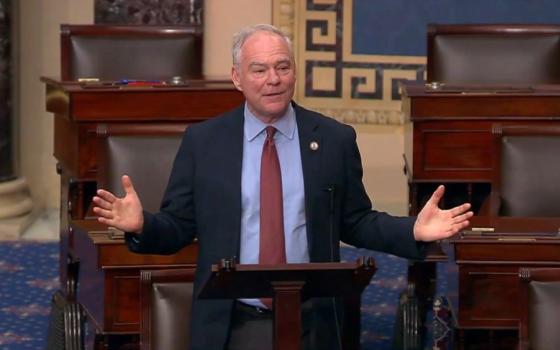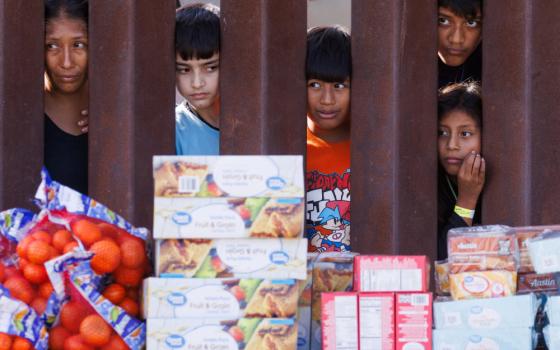It used to be that if you asked a question about the Catholic church, you got very straightforward answers. No, we did not eat meat on Friday. Yes, we had to go to church every Sunday.
Not any more.
In fact, the answers are getting more confusing all the time. Consider the question of how the newly revised Roman Missal is better than the last, for instance.
They tell us now that Mass texts -- including even hymns -- may not include feminine references to God. And this in a church that has routinely addressed God as Key of David, Door of life, wind, fire, light and dove. God who is also, they tell us, "pure spirit" can never, ever, be seen as 'mother.' Are we to think, then, that even hinting at the notion that the image of God includes the image of women as well as the image of men, as God in Genesis says it does, is dangerous to the faith? Antithetical to the faith? Heresy?
Or, too, we learned that the words of the consecration itself would soon be edited to correct the notion that Jesus came to save "all" -- as we had been taught in the past -- to the idea that Jesus came to save "many." The theological implications of changing from "all" to "many" boggles the mind. Who is it that Jesus did not come to save?
Does such a statement imply again that "only Catholics go to heaven?" And, if read like that by others, is this some kind of subtle retraction of the whole ecumenical movement?
Now, this week, we got the word that the pope himself, contrary to the advice and concerns of the world's bishops, has restored the Tridentine Latin Rite. It is being done, the pope explains, to make reconciliation easier with conservative groups.
But it does not, at the same time, make reconciliation easier with women, who are now pointedly left out of the Eucharistic celebration entirely, certainly in its God-language, even in its pronouns. Nor does it seem to care about reconciliation with Jews who find themselves in the Tridentine Good Friday rite again as "blind" and objects of conversion. It's difficult not to wonder if reconciliation is really what it's all about.
What's more, where, in the intervening years, bishops had to give permission for the celebration of Tridentine masses in the local diocese, the new document requires only that the rite be provided at the request of the laity.
But why the concerns? If some people prefer a Latin mass to an English mass, why not have it?
The answer depends on what you think the Mass has to do with articulating the essence of the Christian faith.
The Latin Mass, for instance, in which the priest celebrates the Eucharist with his back to the people, in a foreign language -- much of it said silently or at best whispered -- makes the congregation, the laity, observers of the rite rather than participants in it.
The celebrant becomes the focal point of the process, the special human being, the one for whom God is a kind of private preserve.
The symbology of a lone celebrant, removed from and independent of the congregation, is clear: ordinary people have no access to God. They are entirely dependent on a special caste of males to contact God for them. They are "not worthy," to receive the host, or as the liturgy says now, even to have Jesus "come under my roof."
The Eucharist in such a setting is certainly not a celebration of the entire community. It is instead a priestly act, a private devotion of both priest and people, which requires for its integrity three "principal parts" alone -- the offertory, the consecration and the communion. The Liturgy of the Word -- the instruction in what it means to live a Gospel life -- is, in the Tridentine Rite, at best, a minor element.
In the Latin mass, the sense of mystery -- of mystique -- the incantation of "heavenly" rather than "vulgar" language in both prayer and music, underscores a theology of transcendence. It lifts a person out of the humdrum, the dusty, the noisy, the crowded chaos of normal life to some other world. It reminds us of the world to come -- beautiful, mystifying, hierarchical, perfumed -- and makes this one distant. It takes us beyond the present, enables us, if only for a while, to "slip the surly bonds of earth" for a world more mystical than mundane.
It privatizes the spiritual life. The Tridentine Mass is a God-and-I liturgy.
The Vatican II liturgy, on the other hand, steeps a person in community, in social concern, in the hard, cold, clear reality of the present. The people and priest pray the Mass together, in common language, with a common theme. They interact with one another. They sing "a new church into being,' non-sexist, inclusive, centered together in the Jesus who walked the dusty roads of Galilee curing the sick, raising the dead, talking to women and inviting the Christian community to do the same.
The Vatican II liturgy grapples with life from the point of view of the distance between life as we know it and life as the gospel defines it for us. It plunges itself into the sanctifying challenges of dailiness.
The Vatican II liturgy carries within it a theology of transformation. It does not seek to create on earth a bit of heaven; it does set out to remind us all of the heaven we seek. It does not attempt to transcend the present. It does seek to transform it. It creates community out of isolates in an isolating society.
There is a power and a beauty in both liturgical traditions, of course. No doubt they both need a bit of the other. Eucharist after all is meant to be both transcendent and transformative. But make no mistake: In their fundamental messages, they present us with more than two different styles of music or two different languages or two different sets of liturgical norms. They present us with two different churches.
The choice between these two different liturgies brings the church to a new crossroads, one more open, more ecumenical, more communal, more earthbound than the other. The question is which one of them is more likely to create the world Jesus models and of which we dream.
There are many more questions ahead of us as a result of this new turn in the liturgical road than simply the effect of such a decree on parish architecture, seminary education, music styles, language acquisition and multiple Mass schedules.
The theological questions that lurk under the incense and are obscured by the language are far more serious than that. They're about what's really good for the church -- ecumenism or ecclesiastical ghettoism, altars and altar rails, mystique or mystery, incarnation as well as divinity, community or private spirituality?
From where I stand, it seems obvious that the Fathers of Vatican Council II knew the implications of the two different Eucharistic styles then and bishops around the world know it still. But their concerns have been ignored. They don't have much to do with it anymore. Now it's up to the laity to decide which church they really want -- and why. Which we choose may well determine the very nature of the church for years to come.



